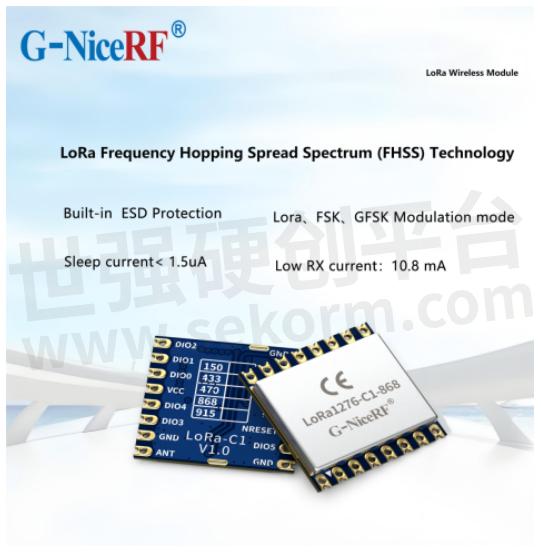How to Enhance LoRa Communication Effectiveness by Improving Anti-Interference Capabilities

LoRa (Long Range) technology, known for its long-distance transmission, low power consumption, and strong anti-interference capabilities, has been widely used in the Internet of Things (IoT) field. The excellent anti-interference capabilities of LoRa technology not only enhance signal stability and transmission distance but also improve data reliability. However, in complex wireless environments, further enhancing LoRa's anti-interference capabilities is crucial for ensuring reliable data transmission.
Enhancing LoRa's anti-interference capabilities to improve communication quality can be approached from multiple aspects, including hardware design, software optimization, the use of frequency hopping, and optimizing spreading factors and bandwidth, among other factors.
Hardware Design
Selecting the Appropriate Frequency Band
Select the most suitable frequency band based on the application scenario requirements, avoiding high-interference bands.
Selecting the Appropriate Antenna
Use high-quality antennas, optimize the antenna position and direction to improve signal reception and transmission efficiency, and ensure impedance matching between the antenna and the module to reduce signal reflection and loss.
Shielding Interference Sources
Add electromagnetic shielding in the module design to reduce external electromagnetic interference.
Software Optimization
Frequency Hopping Technology
Adopt frequency hopping technology to make the signal jump between different frequencies, reducing the impact of interference on any single frequency.
Adjust Transmission Parameters
Such as bandwidth, spreading factor, and coding rate, to improve anti-interference capabilities.

Technically, improving LoRa's anti-interference capabilities to enhance communication quality can be achieved through the following measures:
Use frequency hopping
Make the signal hop between multiple frequencies to avoid interference on fixed frequency bands. Implement frequency hopping in the LoRa network by configuring hopping sequences and parameters to ensure that the transmission frequency continuously changes.
Optimize the spreading factor
A larger spreading factor can provide stronger anti-interference capabilities but will reduce the data rate. Adjust the spreading factor according to the application scenario and interference conditions to balance anti-interference capabilities and data rate.
Adjust the bandwidth
A smaller bandwidth can reduce interference but will decrease data transmission rate. When configuring LoRa modules, choose the appropriate bandwidth and optimize it based on the interference conditions.
Enable Forward Error Correction (FEC)
Increase data redundancy to enhance data recovery capability in noisy environments.

Adaptive Data Rate
Dynamically adjust the data rate and transmission parameters based on network conditions to optimize transmission quality.
Real-time Monitoring: LoRa devices continuously monitor the quality and interference of the current channel.
Rate Adjustment: Based on the monitoring results, LoRa devices can automatically adjust the transmission rate. In low-interference environments, the device can select a higher transmission rate to increase data throughput; in high-interference environments, the device will lower the transmission rate to enhance anti-interference capabilities.
Signal Modulation Optimization
Use stronger modulation techniques (such as FSK or GFSK) to improve anti-interference performance.
Channel Selection and Frequency Planning
Proper channel selection and frequency planning are crucial for reducing interference and enhancing communication quality. Analyze the operating frequencies of other wireless devices in the surrounding environment to avoid selecting the same or adjacent frequencies, thereby reducing potential interference.
In a LoRa network, you can optimize communication quality through frequency allocation and channel management. For example, using frequency hopping technology to switch between multiple channels can distribute interference more evenly and reduce the interference load on any single channel.
Enhancing the anti-interference capabilities of LoRa modules is crucial for ensuring stable communication in complex wireless environments. By employing techniques such as spreading spectrum technology, selecting appropriate spreading factors, optimizing channel selection and frequency planning, using forward error correction coding, and implementing adaptive data rates, LoRa can significantly improve communication quality and ensure reliable data transmission.
The comprehensive application of these techniques makes LoRa excel in the Internet of Things (IoT) field, meeting the stringent requirements for stability and reliability across various application scenarios. In smart cities, agricultural monitoring, industrial control, and many other fields, LoRa's excellent anti-interference capabilities and stable communication quality have established it as a core technology in IoT communication. With ongoing optimization and upgrades of these anti-interference technologies, LoRa will continue to provide reliable communication solutions in complex and dynamic wireless environments.
- +1 Like
- Add to Favorites
Recommend
- G-NiceRF LoRa Backscatter Device LoRa1276-C1 Provides Long-Range Communication with Low-Power
- LoRa1276-C1 Wireless Module with Output Power of 100mW is Suitable for Industrial Applications, Has Obtained FCC, IC, and CE certifications
- What is the RSSI Function of LoRa Module
- G-NiceRF‘s FCC Certified Products for Wireless Transceiver Module: LoRa1276-915, RF2401PRO, RF2401F20, RF4463PRO
- Market Price and Development Prospects of LoRa Module
- G-NiceRF LoRa1121 Module Newly Released: Enables Multi-Band Compatibility and Satellite Communication Functionality
- LoRa126X Series LoRa Modules: Designed Specifically for the Internet of Things
- DEMO kit tutorial of LoRa module LoRa1262
This document is provided by Sekorm Platform for VIP exclusive service. The copyright is owned by Sekorm. Without authorization, any medias, websites or individual are not allowed to reprint. When authorizing the reprint, the link of www.sekorm.com must be indicated.

































































































































































































































































































































































































































































































































































































































































































































































































































































































